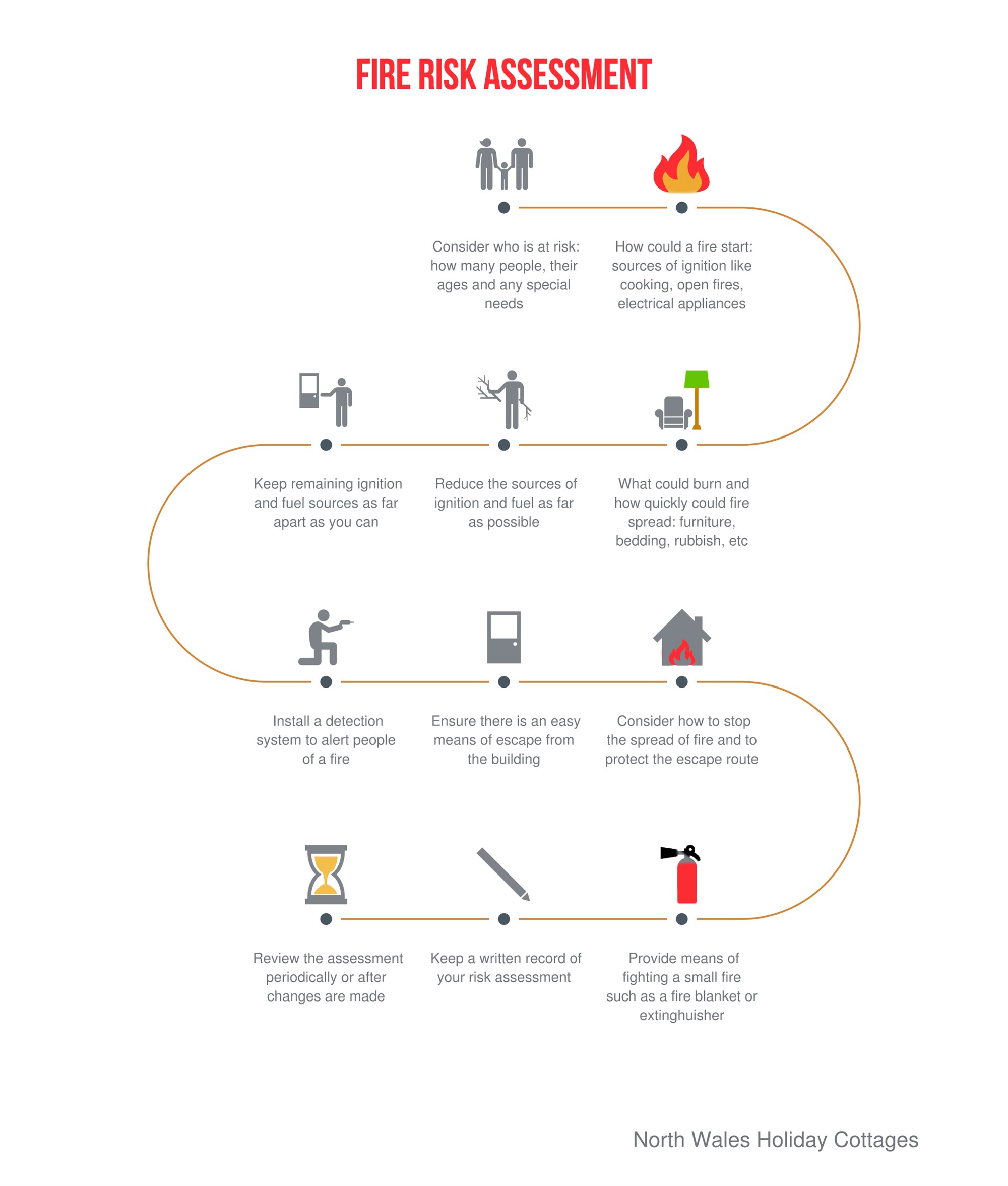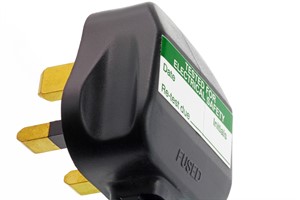Holiday Home Fire Risk Assessment Template
Posted on 22/11/2016 by David
There are around 40,000 domestic fires in the UK each year. As owners of holiday lets you have an obligation to make sure your property is safe for guests staying there. Conducting a fire risk assessment is a legal requirement and provides you with a plan for keeping your house and your guests safe. This guide gives an overview and suggests things to consider which we hope you will find useful, further information can be found at the end of the blog.
How do you conduct a fire risk assessment?
The risk assessment identifies possible ways a fire may start in your house, how it could spread, how people can be alerted to fires and how they will escape from the building. Once risks and possible issues have been identified you can then take steps to eliminate or reduce these risks. Below is an infographic giving an overview of the process:

Who is at risk?
Consider the types of people who may be staying at your property, the number, their ages or any particular disabilities they may have. Also consider anyone else who may visit the property such as cleaners or builders. Could their activities create any risks or would some people have difficulty getting out of the building in an emergency? Remember to take this into account in each of the steps below.
Sources of ignition
Fires always have a source of ignition. The most common place for a fire to start is the kitchen with 50% of accidental domestic fires ignited by cooking appliances. Faulty electrical equipment and leads is the second most common source.
Sources of fuel
What could burn in your property? The most common thing to catch fire is food stuffs including grease and oil (the kitchen again) with 27% of all incidents starting this way closely followed by textiles, upholstery and furnishings at 26%. Ensure your furniture complies with fire regulations, this means they will meet standards of how easily they catch fire, how quickly they burn and the smoke they produce. Furniture bought in the UK since 1990 should comply with these rules.
Reduce sources of ignition and fuel
What did you identify in the previous steps and how could you reasonably remove or reduce these? Examples include checking electrical appliances to make sure they are safe and undamaged, best practice would be for all items to be PAT tested. Don't overload electrical sockets. Do you permit smoking in the house or candles?

For fuel sources you could make sure you keep the kitchen clean from a build-up of grease, replace or clean the extractor fan filters as required, empty crumbs from the toaster and ensure the tumble drier filters are cleared. Don't store rubbish which could catch fire (including outside the property which may invite arson).
Separate Sources of ignition and fuel
After looking at all the ways you can reduce sources of ignition and fuel there will always be some items that you can't reasonably remove such as cookers or heaters and soft furnishings. In these cases make sure they are kept apart, for example make sure towels and dish clothes are stored away from the toaster, oven and other heat sources. If you have an open fire you should provide a fire guard to prevent sparks escaping and have the chimney swept at least once a year. If you have candles make sure they are contained in holders with sides higher than the maximum flame height.
Detection Systems
If there is a fire how will people be alerted to it? In most cases the best solution would be a number of interlinked smoke and heat detectors which are powered by the mains. Heat detectors are used in locations where it may not be appropriate to have a smoke detector such as the kitchen or in a garage. Interlinked means that if one detector is triggered all the detectors will sound an alarm. This is particularly important for larger houses, imagine a fire starting on the ground floor at one end of a house with someone sleeping on the first floor at the other end of the house – would they hear the alarm? As a minimum you will need one smoke detector on each floor of the house but you need to think about your property, would that be enough? Bear in mind that the most common reason for smoke detectors failing to operate when there is a fire is because the smoke did not reach them (55% of cases in Wales). When locating the detectors follow the manufacturer's instructions and think about where fires are likely to start, how would smoke or heat reach the detector. Most detectors are a combined detector and alarm sounder so also take into account the distance from the alarm to people.
Make sure the smoke detectors are checked regularly, you could make it part of the cleaning process before each booking. Figures for Wales in 2015-16 show that 13% of smoke detectors which failed to operate was due to defective or missing batteries. Keep detectors free of dust which helps prevent false alarms.

There are a number of different products available including combined smoke and CO detectors and systems that are connected to the internet, alerting you when smoke is detected wherever you may be. It could be that your property requires a more complex "panel" type system, particularly if it is a large house. Seek professional advice if you are unsure.
Escape Routes
Once a fire is detected and the occupants alerted, how will they escape from the house? Make sure there is a clear path to the exits and it is protected from fire and smoke. Remember that people identified in the first step (who is at risk?) may not be familiar with the layout of the house, will they need emergency lighting if this happens during the night? Supplying a clearly identifiable torch may be enough or you may find that street lighting outside the house is sufficient to light the way. If there are several bedrooms and the route is quite long then it may be more appropriate to install automatic emergency lighting. Will visitors remember where they left the keys to unlock the door, particularly for large houses which sleep lots of people? Consider using a lock which can be opened from the inside without a key.

The sources of ignition and fuel you identified above will suggest areas of the house with a higher fire risk (such as the kitchen). Is there an escape route which avoids this area? Do you need to protect the escape route from these high risk areas by installing fire doors? In most cases a well fitted solid door suffice but think about how this fits with your escape plans.
Provide fire escape information in your property information folder as well as contact number for emergencies, remember that your guests may not be from this country.
Fire Fighting Equipment
It is a Visit Wales requirement that the kitchen should have a fire blanket or fire extinguisher. All such equipment should be inspected regularly, serviced as required and withdrawn when past its expiry date.
Record Keeping
Make sure you keep a written record of all risk assessments and the date they were completed. You can then review these assessments on an annual basis or whenever any changes are made to the property. It's also proof that you have undertaken the task.
Risk Assessment template
There are a number of templates that you can find online with different ways of recording information. Some can be extremely detailed, find one which is appropriate to your situation. Here is a a risk assessment template as suggested by Visit Britain and an example of a completed risk assessment.
As an alternative you may consider using this template which has a format similar to a standard risk assessment.
Further information:
A basic guide to fire-safety can be found here
Visit Britain has some helpful information on a range of topics on their website
North Wales Fire and Recue Service website
Statistics come from
Fire Statistics England 2014/15: https://www.gov.uk/government/uploads/system/uploads/attachment_data/file/532364/fire-statistics-england-1415-hosb0816.pdf
Stats Wales:https://statswales.gov.wales/Catalogue/Community-Safety-and-Social-Inclusion/Community-Safety/Fire-Incidents
Source: https://www.northwalesholidaycottages.co.uk/let-your-cottage/property-letting-blog/letting-a-holiday-cottage/fire-risk-assessments/
0 Response to "Holiday Home Fire Risk Assessment Template"
Post a Comment